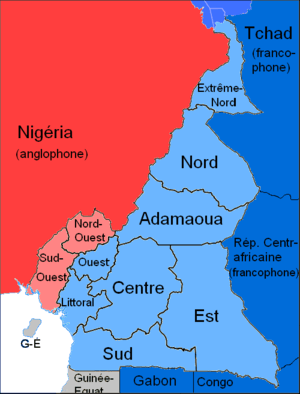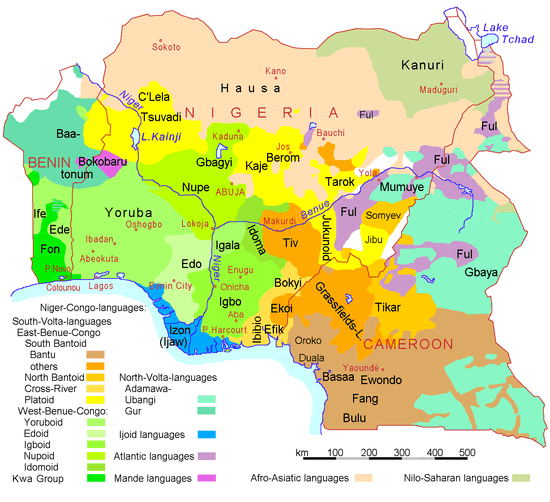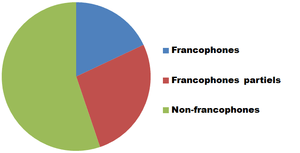Languages of Cameroon
Cameroon is home to at least 250 languages.[2][3] These include 55 Afro-Asiatic languages, two Nilo-Saharan languages, four Ubangian languages, and 169 Niger–Congo languages. This latter group comprises one Senegambian language (Fulfulde), 28 Adamawa languages, and 142 Benue–Congo languages (130 of which are Bantu languages).[4] French and English are official languages, a heritage of Cameroon's colonial past as a colony of both France and the United Kingdom from 1916 to 1960. Eight out of the ten regions of Cameroon are primarily francophone, representing 83% of the country's population, and two are anglophone, representing 17%. The anglophone proportion of the country is in constant regression, having decreased from 21% in 1976 to 20% in 1987 and to 17% in 2005, and is estimated at 16% in 2015 (whose fourth census should take place in 2015).[5][6]
| Languages of Cameroon | |
|---|---|
| Official | French, English |
| National | 55 Afro-Asiatic languages, two Nilo-Saharan languages, and 173 Niger–Congo languages |
| Signed | American Sign Language (Francophone African Sign Language) |
| Lingua franca(s) | French, English, Camfranglais, Cameroonian Pidgin English |
| Part of a series on the |
| Culture of Cameroon |
|---|
 |
| History |
| People |
| Languages |
| Cuisine |
| Religion |
| Art |
| Literature |
|
Music and performing arts |
|
Media |
| Sport |
|
Monuments
|
|
Symbols |
|


The nation strives toward bilingualism, but in reality very few Cameroonians speak both French and English, and many speak neither. The government has established several bilingual schools in an effort to teach both languages more evenly; however, in reality most of these schools separate the anglophone and francophone sections and therefore do not provide a true bilingual experience.[7] Cameroon is a member of both the Commonwealth of Nations and La Francophonie. German, the country's official language during the German colonial period until World War I, has nowadays almost entirely yielded to its two successors. However, as a foreign language subject German still enjoys huge popularity among pupils and students, with 300,000 people learning or speaking German in Cameroon in 2010. Today, Cameroon is one of the African countries with the highest number of people with knowledge of German.[8]
Most people in the English-speaking Northwest and Southwest provinces speak Cameroonian Pidgin English as a lingua franca.[9] Fulfulde serves the same function in the north, and Ewondo in much of the Center, South, and East provinces.[10] Camfranglais (or Frananglais) is a relatively new pidgin communication form emerging in urban areas and other locations where Anglophone and Francophone Cameroonians meet and interact. Popular singers have used the hybrid language and added to its popularity.[11]
Education for the deaf in Cameroon uses American Sign Language, introduced by the deaf American missionary Andrew Foster.
There is little literature, radio, or television programming in native Cameroonian languages. Nevertheless, many Cameroonian languages have alphabets or other writing systems, many developed by the Christian missionary group SIL International, who have translated the Bible, Christian hymns, and other materials. The General Alphabet of Cameroon Languages was developed in the late 1970s as an orthographic system for all Cameroonian languages.
In the late 19th century, the Bamum script was developed by Sultan Ibrahim Njoya to write the Bamum language.[10]
Official languages
|
|
|
|
Literacy in French for individuals of age 12 and above rose from 41.3% to 57.6%[15] between 1987 and 2005 while that of English rose from 13.4% to 25.3%.[16] The global proportion of individuals literate in official languages has thus markedly increased between 1987 and 2005, rising from 53.3% to 71.2%.[17]
In 2005, the probability to be literate in French while being anglophone was 0.46 while that of being literate in English while being francophone was 0.20, resulting from the predominant status of the French language in Cameroon as a whole.
Indigenous languages
Some of the common languages native to Cameroon include:
| Name | Speakers | ||||
|---|---|---|---|---|---|
| Abo | |||||
| Afade | |||||
| Aghem | |||||
| Akoose | |||||
| Akum | |||||
| Ambele | |||||
| Arabic, Chadian | 171,000 | ||||
| Atong | |||||
| Awing | |||||
| Babanki | |||||
| Bafanji | |||||
| Bafaw-balong | |||||
| Bafia | |||||
| Bafut | |||||
| Baka | |||||
| Bakoko | |||||
| Bakole | |||||
| Bakundu-balue | |||||
| Bakweri | |||||
| Baldamu | 4 | ||||
| Balo | |||||
| Balundu-bima | |||||
| Bamali | |||||
| Bambalang | |||||
| Bambili | |||||
| Bamenyam | |||||
| Bamiléké | |||||
| Bamukumbit | |||||
| Bamoun | |||||
| Bamumbu | |||||
| Bamunka | |||||
| Bana | |||||
| Bangandu | |||||
| Bangolan | |||||
| Bangwa | |||||
| Bansop | |||||
| Barombi | |||||
| Bassa | |||||
| Bassossi | |||||
| Bata | |||||
| Batanga | 6,000 | ||||
| Bati | |||||
| Bayangam | |||||
| Bebe | |||||
| Bebele | |||||
| Bebil | |||||
| Beezen | |||||
| Befang | |||||
| Bekwel | |||||
| Beti | |||||
| Bikya | |||||
| Bishuo | |||||
| Bitare | |||||
| Bokyi | |||||
| Bomwali | |||||
| Bu | |||||
| Bubia | |||||
| Buduma | |||||
| Bulu | |||||
| Bumbung | |||||
| Busam | |||||
| Busuu | 3 | ||||
| Buwal | |||||
| Byep | |||||
| Caka | |||||
| Cung | |||||
| Cuvok | |||||
| Daba | |||||
| Dama | |||||
| Dek | |||||
| Denya | |||||
| Dii | |||||
| Dimbong | |||||
| Doyayo | |||||
| Duala | |||||
| Dugwor | |||||
| Duli | |||||
| Duupa | |||||
| Dzodinka | 2,600 | ||||
| Efik | |||||
| Ejagham | |||||
| Elip | |||||
| Eman | |||||
| Esimbi | |||||
| Eton | |||||
| Evand | |||||
| Ewondo | |||||
| Fali | |||||
| Fang | 111,000 | ||||
| Fe'fe' | |||||
| Fulfulde | |||||
| Fungom | |||||
| Gaduwa | |||||
| Gavar | |||||
| Gbaya | |||||
| Ghomala | |||||
| Guiziga | |||||
| Hausa | 25,000 | ||||
| Kenyang[18] | Kom | Kotoko | |||
| Kwasio / Ngumba | |||||
| Limbum | |||||
| Mafa | |||||
| Mambila | |||||
| Massa | |||||
| Mousgoum | |||||
| Mousseye | |||||
| Medumba | |||||
| Meta'a | |||||
| Moghamo | |||||
| Mundang | |||||
| Nda'nda' | |||||
| Nso' | |||||
| Nweh | |||||
| Tikar | |||||
| Toupouri | |||||
| Wuté | |||||
| Yabassi | |||||
| Yamba | |||||
Mousgoum, Massa, Kotoko, and Mousseye are spoken on the Logone River in the Far North.
See also
- Demographics of Cameroon
- General Alphabet of Cameroon Languages
- Francophone Africa
References
- Estimation of number of French speakers worldwide. Archived 2010-01-20 at the Wayback Machine, Francophonie.org
- "Ethnologue: Languages of the World".
- Kouega, Jean-Paul. 'The Language Situation in Cameroon', Current Issues in Language Planning, vol. 8/no. 1, (2007), pp. 3-94.
- Neba 65.
- "Archived copy". Archived from the original on 2016-03-04. Retrieved 2016-03-16.CS1 maint: archived copy as title (link)
- "Portail de données du Cameroun, Analyse de Données". Cameroon.africadata.org. Archived from the original on 2017-02-25. Retrieved 2017-08-26.
- DeLancey and DeLancey 51.
- "Wenn Deutsch gleich Zukunft heißt", Dw.com, 29 Nov. 2010
- DeLancey and DeLancey 220.
- DeLancey and DeLancey 192.
- DeLancey and DeLancey 131.
- "Troisième RGPH (2005) - Alphabétisation". Bucrep.cm (in French). p. 220. Retrieved 2017-08-26.
- "Les dynamiques démolinguistiques au Cameroun de 1960 à 2005" (PDF). Odsef.fss.ulaval.ca. p. 77. Retrieved 2017-08-26.
- "Archived copy". Archived from the original on 2015-07-15. Retrieved 2016-03-16.CS1 maint: archived copy as title (link)
- "Dynamique des langues nationales et officielles au Cameroun de 1987 à 2005" (PDF). Erudit.org. p. 13. Retrieved 2017-08-26.
- "Dynamique des langues nationales et officielles au Cameroun de 1987 à 2005" (PDF). Erudit.org. p. 12. Retrieved 2017-08-26.
- "Les dynamiques démolinguistiques au Cameroun de 1960 à 2005 : un éclairage à travers les données des recensements" (PDF). Odsef.fss.ulaval.ca. p. 56. Retrieved 2017-08-26.
- "Kenyang". Ethnologue.com. Retrieved 2017-08-26.
Sources
- DeLancey, Mark W., and DeLancey, Mark Dike (2000): Historical Dictionary of the Republic of Cameroon (3rd ed.). Lanham, Maryland: The Scarecrow Press.
- Neba, Aaron, Ph.D. (1999). Modern Geography of the Republic of Cameroon, 3rd ed. Bamenda: Neba Publishers.
External links
- Ethnologue page on Languages of Cameroon
- PanAfriL10n page on Cameroon
- Aménagement linguistique dans le monde - Cameroun
- Leinyui, Usmang Salle. n.d. "Bilingualism." TranslationDirectory.com (article focuses on Cameroon)
- Rosendal, Tove. 2008. "Multilingual Cameroon: Policy, Practice, Problems and Solutions." University of Gothenburg, Africana Informal Series, No. 7
